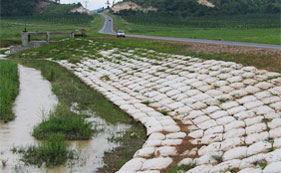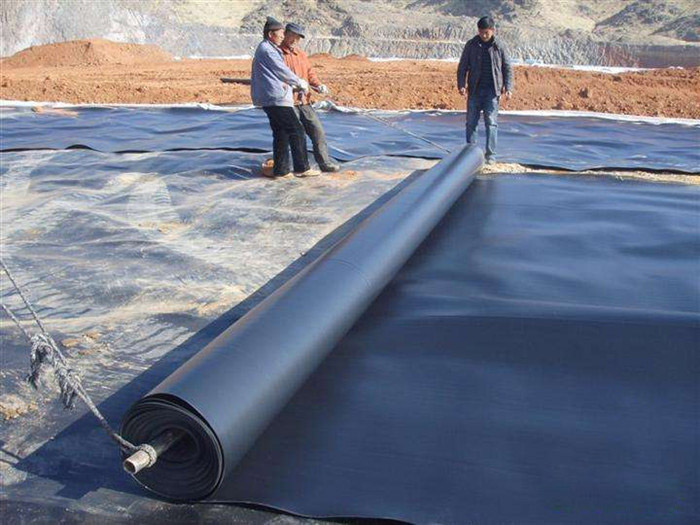
 Back to List
Back to List

Reservoir/breeding anti-seepage system construction plan
1. Overview
The Erba Reservoir is located in Jiantan Town, about 18km east of Ganzhou City, Zhangye City, Gansu Province, on the lower reaches of Shandan River. The reservoir has a total storage capacity of 4 million m3 and a Xingli storage capacity of 3.68 million m3. It is a comprehensive reservoir that mainly focuses on agricultural irrigation and also has flood control, tourism, and aquaculture functions. The reservoir was built in 1958, and the main dam is a homogeneous earth dam. The main dam of the reservoir is 1140m long, the dam crest width is 3.0~4.0m, the dam crest elevation is 1495.00m, the normal water storage level is 1491.30m, the dam bottom elevation is 1487.55~1488.80m, the inner slope ratio of the dam is 1:3~1:4.5, The road has an elevation of 1493.00m and a width of 1.5m. The slope ratio of the rear dam is 1:2. Due to the constraints of the construction environment and objective conditions at the time, there was no seepage prevention at the bottom of the reservoir in front of the dam, no seepage prevention treatment was performed on the dam foundation of the reservoir during the construction, the dam body was not compacted, and there was no drainage body behind the dam. Perennial seepage behind the dam, and piping occurred at high water levels.
In 2002, it was appraised by the Reservoir Dam Safety Appraisal Committee that the seepage slope of the dam slope was greater than the promised seepage slope, and the seepage of the dam slope was unstable, and the dam body needed to be treated with anti-seepage treatment.
2. The selection of the design plan for the risk removal and reinforcement
Through the economic and technical comparison of multiple schemes, combined with the actual situation of the dam material and construction conditions of this project and the treatment experience of similar projects, the design and selection of the remediation scheme of using composite geomembrane to treat earth dam leakage. The composite geomembrane is designed to prevent seepage treatment from the top of the main dam to the foot of the dam, and the composite geomembrane cover is laid within 25m of the bottom of the dam front reservoir. To excavate the alveolar at the front end of the bedding, insert the composite geomembrane into the alveolar, insert the composite geomembrane into the original dam body after the dam crest is slotted, and connect the composite geomembrane to the building concrete at the junction of the dam body, the spillway and the water conveyance tunnel, A semi-closed water-tight and impermeable structure is formed. After reinforcement, the dam crest elevation is 1495.00m, the dam crest width is 4.0m, and the front dam slope is 1:3~1:4.5. At the front dam slope 1493.00m, a 1.5m wide horse track doubles as a sidewalk, and the rear dam slope ratio is 1 :2.
3. Construction method
a. One cloth and one membrane (200g/0.5mm) geomembrane anti-seepage cloth (geomembrane) is used for lake bottom seepage prevention. Materials should be ventilated and dry when stored on site, not exposed to sunlight, and kept away from fire sources.
b. Before laying the anti-seepage cloth, it is necessary to remove the lake bottom water and silt, and compact the soil to prevent the base surface from being uneven and the sharp edges of broken stones are exposed, and the ventilation treatment should be done. The construction method of the ventilation ditch is the same as that of the sand pit.
c. Lay the anti-seepage cloth, from one end to the other end, and other treatment measures should be taken at the junction with the side slope, and the grass slope should be connected naturally.
d. The joint laying of the impermeable cloth should be kept overlapping by 10 cm, and the joints should be treated with strong adhesion or heat sealing.
e. In order to protect the impermeable cloth from aging or damage, cover the bottom surface with a sand layer or soil layer of 20-30 cm. The hard materials in the backfill layer should be cleaned up.
4. Slope engineering: The slope treatment of reservoir (artificial lake) generally has the following types, and the specific types are adopted according to the requirements of different sections:
1) Natural slope: The upper part is connected with the grass slope to form a clear water and grass boundary. The slope is compacted during the modeling process.
2) Slope of mortar rubble: It can be divided into vertical slope and inclined slope.
3) Anti-scour biological blanket slope protection, a good product for slope protection, patented product of Hongxiang Co., Ltd.
4) Geocell slope protection
5) Drainage can use composite drainage net
(Reservoir (artificial lake) There are three types of new anti-seepage materials: HDPE anti-seepage membrane, PE composite geomembrane, GCL bentonite waterproof blanket, and two slope protection products: anti-scouring biological blanket, geocell, and one drainage product: Composite drainage net)
Laying of composite geomembrane
1) Laying method of composite geomembrane
Composite geomembrane laying is divided into two parts: bottom laying and slope laying. Laying method: The laying of composite geomembrane requires that a narrow width of 4m is spliced and welded to a width of 20m on a flat ground, and then the slope is laid in a wide width from top to bottom, perpendicular to the dam axis. After the slope is laid on the slope, it is slowly spread from the top of the embankment to the foot of the embankment in the direction perpendicular to the axis of the embankment until the outer top of the slope toe alveolar meets the geomembrane at the bottom of the reservoir in a T shape. After the bottom of the storage is laid at the bottom of the storage and passed the excavation and acceptance, it is slowly spread from the top of the tooth groove to the inside of the storage in the direction perpendicular to the axis of the embankment toe to 25m inside the storage.
2) Technical requirements for laying composite geomembrane
Laying should be carried out in dry and warm weather. In order to facilitate splicing and prevent stress concentration, the composite geomembrane is laid in a wave-shaped relaxation method with a margin of about 1.5%. After spreading, it should be flattened and opened in time, requiring composite geomembrane and slope surface The anastomosis is smooth and there are no protrusions and wrinkles. The construction personnel should wear flat-bottomed cloth shoes or soft rubber shoes. Spike shoes are strictly prohibited to avoid stepping on the geomembrane. If the geomembrane is found damaged during construction, it should be repaired in time.
4.3. Splicing of composite geomembrane
1) This project uses two fabrics and one membrane and one fabric and one membrane composite geomembrane. The connection of the composite geomembrane is divided into two procedures, namely, the connection of the lower and upper non-woven fabrics, and the connection of the middle PE film. The seaming of the non-woven fabric is double-sealed with a portable sewing machine and nylon thread, with a lap width of 10cm; the PE film is connected by a welding process, and the welding tool is a double-pass plastic heat sealing machine with an automatic temperature control electric heating mode. Splicing includes the seam of geotextile and the welding of geomembrane. In order to ensure the welding quality, the welding should be carried out in the factory as far as possible. However, for the convenience of construction, the width of the composite geomembrane should not be too wide and must be spliced at the construction site.
2) The welding quality of composite geomembrane is the key to the success or failure of composite geomembrane's anti-seepage performance. Therefore, the welding of geomembrane must be done well to ensure the welding quality. Therefore, the manufacturer of geomembrane welding should be performed by professional technicians on site. , Guidance, training, using special welding equipment for geomembrane. The geomembrane welding of this project adopts the ZPR-210V heat sealing geomembrane welding machine, and the geotextile is sewn by a portable sealing machine.
Reservoir reinforcement project
3) Welding process: After the first geomembrane is laid, the edges to be welded are folded, and the second geomembrane is reversely laid on the first one, and the welding edge direction of the two films is adjusted to overlap 10cm.
4) Welding is all carried out on site. It is required that the weather is fine and the wind is below level 3. It is strictly forbidden to perform construction in rainy, high temperature and severe cold weather. The surface of the welding base should be dry. Before welding, blow off the sand and mud on the membrane surface with a hair dryer. Wipe the objects with a clean towel to ensure that the film surface is clean. Place a long wooden board under the welding part so that the welding machine can walk on a flat base surface to ensure the welding quality. Before the formal welding, it should be based on the construction temperature and PE For the film thickness, use the PE film of the same material for trial welding. The welding temperature is 220~300℃. The temperature and walking speed of the welding machine are well grasped, the construction process parameters are determined, and the formal construction is carried out. The welding seam should be transparent, flat, and Straight and continuous. Two splicing welds, each with a width of 10mm, leaving a cavity of 10mm between the two welds, use this cavity to check the quality of the weld.